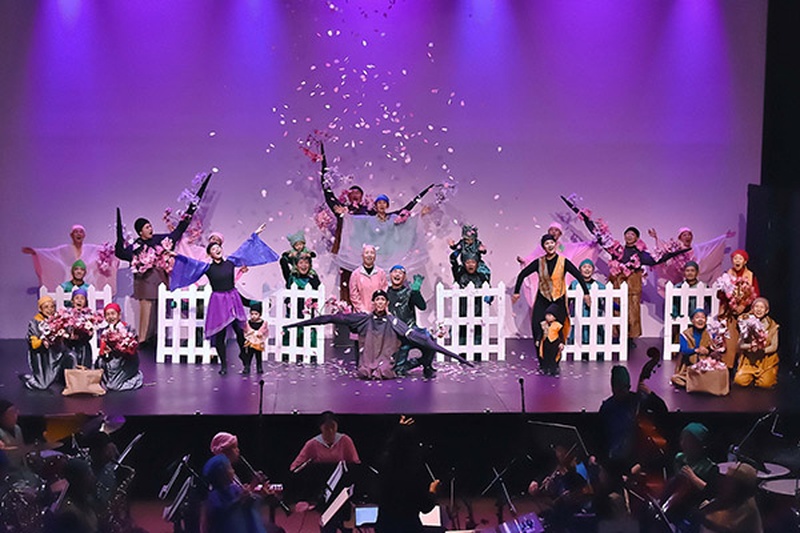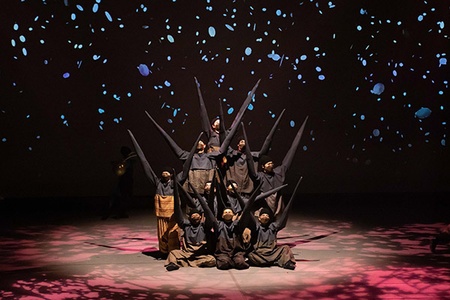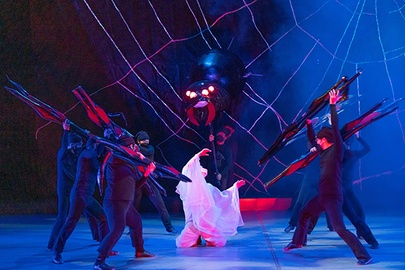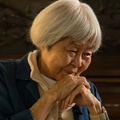“May the world be safe, may the world be kind, may the world forever be our home.”
—Joy Kogawa, Naomi’s Tree
This refrain was sung by Karakoro, a performing art troupe from Osaka, during their musical Naomi’s Tree, based on the 2008 children’s book by Joy Kogawa.
Presented 15 years later, the troupe left the Toronto audience in a state of awe and wonder at the Japanese Canadian Cultural Centre on Aug. 17, 2023. The sentiments expressed were a fitting prayer, given the state of our planet today—the countless and senseless world conflicts such as in Israel and Ukraine, as well as global climate changes.
Yet for this one evening in Kobayashi Hall, in the packed audience of over 300 people of all ages, we let ourselves be transported into the wondrous world of six-year-old Naomi and her beloved cherry tree friend. We were taken through her transformation into an adolescent, then followed her as she aged into a grey-haired elder—all skillfully and creatively executed by seasoned playwright and director Yoko Matsui.
Meanwhile, the Karakoro live orchestra musically carried us throughout the theatrical evening. Gaku Matsui wrote and conducted the musical score, and the lyrics were primarily written by Ikuo Yoshizawa, with others penned by Sanae Oda, Yuka Hirohata, and Yoko Matsui.
From their first song, The Country Where the Sun Rises, we are immediately drawn in by a stylized Japanese cherry tree waking up, blossoming, and spreading its pink petals all around. The noh-like choreography of the tree branches further drew us all into this bicultural musical. Additionally, audience members familiar with the symbolism of the sakura in Japanese culture also knew this flowering represented the bittersweet fleeting nature and beauty of life.
What followed were these three songs, May the World Be Safe, A Seed of [a] Dream, and The Friendship Tree, which explained how the cherry tree came to be planted and grow outside Naomi’s bedroom window in her family’s backyard, bringing them much happiness—flowers, fruit, and shade. Good Night, Cherry Tree conveys the young girl’s growing relationship with her arbor friend. Each evening, she wishes the tree a good night, as she would any family member.
Naomi’s cloistered childhood receives a rude shock when her mother returns to Japan to care for her ailing grandmother while Naomi, her brother, and her father remain behind. Sure to Come Home reflects the heartache of the mother’s departure and the hope she will return someday.
And throughout the renditions of all these songs, the colourful kabuki—like costuming of the fanciful insects bounding about and the humourous kyogen—like creatures create interludes of lightheartedness as the tale becomes more sombre. Much like traditional Japanese theatre, the musicians in the orchestra were visible to the audience.
Also, the intricate (and perhaps very practical) choreography facilitated the interchange of some performers, who, while remaining in character and costume, exchanged places with seated musicians in the orchestra. These exchanges occurred throughout the evening’s performance, thus making full use of the company of 68 multi-talented people.
Then, the Second World War breaks out between Japan and Canada, resulting in Naomi, along with her brother and father, their Japanese Canadian friends and community, being declared “enemy aliens.” They are forced to leave their homes and everything they knew in “the lovely city by the water’s edge.”
The song, Kumo Battle! depicts this drastic shift in a dramatic and seemingly Bunraku-influenced scene. A gigantic black spider clambers onto the darkened stage with its huge web filling the backdrop, while the insect’s body and legs are manipulated by puppeteers. Then, its legs are transformed into weapons, stabbing at a helpless victim in its midst. The legless body of the spider transforms into a bomb. All the while, loud piercing sounds, and flashing red and white lights fill the air.
Deprived of her past life after the war ends, Naomi finds herself drifting from place to place with a sense of loss and aimlessness, far from her once contented life and lovely hometown.
Remember Me! reflects Naomi’s longing for her “Cheery Cherry Tree” friend, her home, and her long-lost childhood. She dreams of returning but realizes it is only a dream, as she is no longer that little girl living that once peaceful life.
After many more years pass, the elderly Naomi and her brother return to their hometown. They happen upon the house where they used to live and their beloved cherry tree. Though all have aged and are worse for wear, they are all heartened by their long-dreamt reunion.
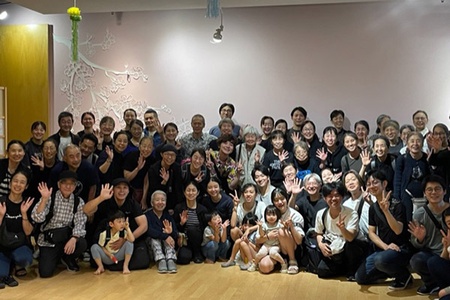
Upon seeing the musical for the first time, author Joy Kogawa wrote to Nikkei Voice in an email, “I was dumbfounded and entranced and thrilled by the whole production. When the written word is translated into […] song and acting […] it becomes more than an expansion, it becomes another art form. The seed flowers and is so much more than it was.”
When the playwright and director, Yoko Matsui, was interviewed by Nikkei Voice about making the musical, she stated: “…I had the image that Canada was a multi-ethnic country and was peaceful and free from discrimination.”
“However, I was surprised to know that Japanese Canadians were discriminated against and had tragic experiences during the war, and at the same time, I was ashamed of knowing nothing about it. I wanted to express something related to discrimination on stage…”
Furthermore, she wrote, “When we performed it in Japan, I had a comment from the audience that they knew of the policy of segregation in the United States during the war but knew nothing about Canada. I wanted to perform it in Canada.”
And so, for Matsui and Kogawa, their wishes came true for them on this August night in Toronto.
And for those who missed this unusual cross-cultural musical, Naomi’s Tree will return in the summer of 2024 to Vancouver, then to Calgary and Lethbridge in an abridged form.
*This article was originally published in the Nikkei Voice on January 18, 2024.
© 2024 Catherine Jo Ishino


